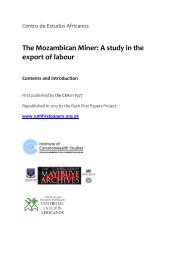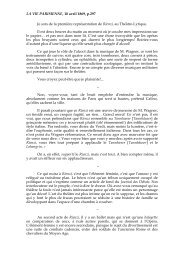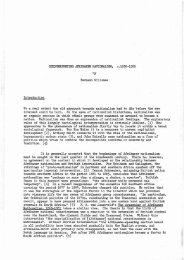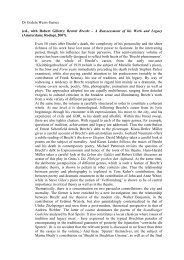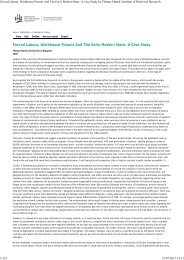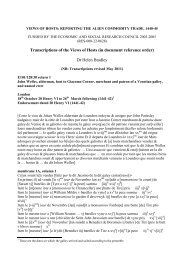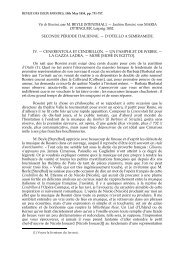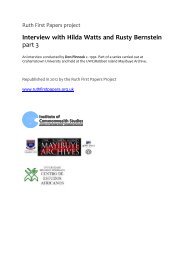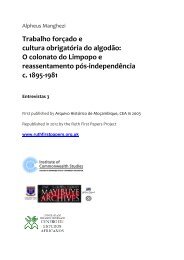Roraima: Brazil's northernmost frontier by John Hemming - SAS-Space
Roraima: Brazil's northernmost frontier by John Hemming - SAS-Space
Roraima: Brazil's northernmost frontier by John Hemming - SAS-Space
Create successful ePaper yourself
Turn your PDF publications into a flip-book with our unique Google optimized e-Paper software.
and occupied the lands of the national fazendas of Sao Bento and the longabandoned<br />
Sao Jose.' 15 By 1906, Ourique said that Sao Bento was divided<br />
into 'many prosperous private ranches on which are raised, with lively<br />
results, thousands of head of cattle, horses and sheep'. 16 And in the years<br />
before 1921, according to Gondim, 'some of these intruders alleged that the<br />
lands were devolutas [unoccupied] and demanded and obtained from various<br />
governors ... the issue of definitive title deeds - as if the national<br />
patrimony were not a sacred right! Those two national properties thus disappeared<br />
from public ownership.' 17 Theodor Koch-Griinberg noted that ranchers<br />
who illegally occupied the vast state-owned properties also branded<br />
any wild cattle they found with their own marks. 18<br />
The one surviving national fazenda, Sao Marcos, occupied the 'V' between<br />
the Uraricoera and Tacutu rivers, bounded to the west <strong>by</strong> the Parime<br />
and east <strong>by</strong> the Surumu, and it extended northwards towards the Pacaraima<br />
hills. This ranch was transferred between government ministries and eventually<br />
in 1916 passed to the new Indian Protection Service (SPI) to administer<br />
on behalf of the Ministry of Agriculture. Before that, its lands and cattle had<br />
been plundered <strong>by</strong> the tenant Sebastiao Diniz. The SPI's administrator of<br />
Sao Marcos complained bitterly that when his lease expired, Diniz withdrew<br />
'with a herd of 20,000 head and title as owner of an usurped ranch called Flechal<br />
- which was nothing more than a good part of the national fazenda Sao<br />
Marcos. He left for the nation a miserable herd of little more than 3,000 cattle,<br />
all old cows and useless for breeding.' 19 Diniz himself argued that he had<br />
returned the 3,000 government-owned cattle of which he had taken custody<br />
in his original contract of 1888.<br />
When Sebastiao Diniz died, his mother Dona Anna Diniz inherited his<br />
Flechal Victoria fazenda. There was a legal action, but Anna Diniz won not<br />
only the usurped ranch but also damages from the State. Koch-Grunberg visited<br />
in 1911, just after Anna Diniz's legal victory. He said that the Brazilian<br />
government had caved in because it feared revolution if it tried to control the<br />
proud fazendeiros of the isolated Rio Branco. The national fazenda Sao Marcos<br />
was vast - 8,000 square kilometres - and contained 18-20,000 head of<br />
cattle. But only 5,000 of these definitely belonged to the government; the<br />
rest were branded with the mark of the late Sebastiao Diniz. 20 After Anna<br />
Diniz's death, the large and aggressive Manaus rubber-trading company J.<br />
G. Araujo e Companhia Ltda. acquired her property (in 1918). Litigation<br />
over the national fazendas and their cattle continued into the higher courts;<br />
but the State never recovered the ranches of Sao Bento or Sao Jose or large<br />
parts of Sao Marcos.<br />
By the 1920s, J. G. Araujo was the largest cattle rancher in the area, with<br />
45,000 head on a series of ranches, particularly in the bend of the right bank<br />
of the Uraricoera-Branco river north of Boa Vista. Across the river and up<br />
the Parime were the lands of Colonel Bento Brazil with 13,000 head. Boa<br />
Vista's leading businessman at that time was Homero Cruz, who administered<br />
the J. G. Araujo herds as well as 3,000 head of Joao Crisostomo Diniz



